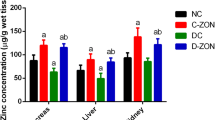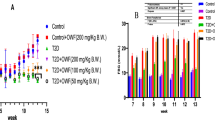Abstract
Objectives
The present study was designed to evaluate the effects of Tyrosol and Nano-tyrosol on the cellular arrangement, collagen disposition, protein level of insulin receptor (INSR), and superoxide dismutase (SOD) activity in both control and streptozotocin-induced diabetic rats.
Methods
Type 2 Diabetes (T2D) was induced in rats by a single intraperitoneal injection of streptozotocin (50 mg/kg). Experimental rats were administered Tyrosol and Nano-tyrosol 1 ml intra-gastrically at a dose of 20 mg/kg once a day for 30 days. Then, rats were sacrificed according to ethical principles. Livers were removed and processed for histological studies using the paraffin technique. Furthermore, non-paraffin sections were used for the INSR-1 western blot technique.
Results
At the end of the experiments, the rats in diabetic control and plain niosome groups exhibited a significant increase in collagen disposition (p < 0.001), and apoptotic cells (p < 0.001), as well as decreased total protein levels of INSR (p < 0.001), and SOD activity (p < 0.001) in the hepatic cells. Oral administration of Tyrosol and Nano-tyrosol to diabetic rats reversed all the above-mentioned parameters to near normal levels (p < 0.001). Nano-tyrosol showed the highest significant effect rather than Tyrosol.
Conclusion
The results of the present study suggested the beneficial effects of Tyrosol and especially Nano-tyrosol on decreasing the adverse effects of diabetes.





Similar content being viewed by others
References
Whiting DR, Guariguata L, Weil C, Shaw J. IDF diabetes atlas: global estimates of the prevalence of diabetes for 2011 and 2030. Diabetes Res Clin Pract. 2011;94(3):311–21.
Chandramohan R, Pari L, Rathinam A, Sheikh BA. Tyrosol, a phenolic compound, ameliorates hyperglycemia by regulating key enzymes of carbohydrate metabolism in streptozotocin induced diabetic rats. Chemico-Biol Interact. 2015;229:44–54.
Dada AO, Ogundele SO, Amisu MA, Williams A. Prescription pattern and treatment target in patients with type 2 diabetes attending a tertiary health center in Lagos. J Diabetol. 2021;12(1):36.
MO J. Diabetes Mellitus. In Cecil Text Book of Medicine; 2000.
Rinella ME. Nonalcoholic fatty liver disease: a systematic review. JAMA. 2015;313(22):2263–73.
Targher G, Byrne CD. Nonalcoholic fatty liver disease: a novel cardiometabolic risk factor for type 2 diabetes and its complications. J Clin Endocrinol Metabolism. 2013;98(2):483–95.
Markova M, Pivovarova O, Hornemann S, Sucher S, Frahnow T, Wegner K, et al. Isocaloric diets high in animal or plant protein reduce liver fat and inflammation in individuals with type 2 diabetes. Gastroenterology. 2017;152(3):571–85. e8.
Tian W, Chen L, Zhang L, Wang B, Li X, Fan K, et al. Effects of ginsenoside Rg1 on glucose metabolism and liver injury in streptozotocin-induced type 2 diabetic rats. Genet Mol Res. 2017;16(1):gmr16019463.
Newgard CB. Interplay between lipids and branched-chain amino acids in development of insulin resistance. Cell Metabol. 2012;15(5):606–14.
Feldman MFL, Brandt LJ, editors. Non-alcoholic fatty liver disease. ELSEVIER; 2006.
Lans CA. Ethnomedicines used in Trinidad and Tobago for urinary problems and diabetes mellitus. J Ethnobiol Ethnomed. 2006;2(1):1–11.
Kono Y, Fridovich I. Superoxide radical inhibits catalase. J Biol Chem. 1982;257(10):5751–4.
Pacher P, Beckman JS, Liaudet L. Nitric oxide and peroxynitrite in health and disease. Physiol Rev. 2007;87(1):315–424.
Bigagli E, Lodovici M. Circulating oxidative stress biomarkers in clinical studies on type 2 diabetes and its complications. Oxidative medicine and cellular longevity. 2019;2019.
Zhu A, Yang X, Sun M, Zhang Z, Li M. Associations between INSR and MTOR polymorphisms in type 2 diabetes mellitus and diabetic nephropathy in a Northeast Chinese Han population. Genet Mol Res. 2015;14(1):1808–18.
Okamoto H, Obici S, Accili D, Rossetti L. Restoration of liver insulin signaling in Insr knockout mice fails to normalize hepatic insulin action. J Clin Investig. 2005;115(5):1314–22.
Santoleri D, Titchenell PM. Resolving the paradox of hepatic insulin resistance. Cell Mol Gastroenterol Hepatol. 2019;7(2):447–56.
Karković Marković A, Torić J, Barbarić M, Jakobušić Brala C. Hydroxytyrosol, tyrosol and derivatives and their potential effects on human health. Molecules. 2019;24(10):2001.
Chandramohan R, Pari L. Anti-inflammatory effects of tyrosol in streptozotocin-induced diabetic Wistar rats. J Funct Foods. 2016;27:17–28.
Castro-Barquero S, Lamuela-Raventós RM, Doménech M, Estruch R. Relationship between Mediterranean dietary polyphenol intake and obesity. Nutrients. 2018;10(10):1523.
Cicerale S, Lucas L, Keast R. Biological activities of phenolic compounds present in virgin olive oil. Int J Mol Sci. 2010;11(2):458–79.
Chandramohan R, Saravanan S, Pari L. Beneficial effects of tyrosol on altered glycoprotein components in streptozotocin-induced diabetic rats. Pharm Biol. 2017;55(1):1631–7.
Pacifici F, Farias CLA, Rea S, Capuani B, Feraco A, Coppola A, et al. Tyrosol May Prevent Obesity by Inhibiting Adipogenesis in 3T3-L1 Preadipocytes. Oxidative medicine and cellular longevity. 2020;2020.
Neveu V, Perez-Jiménez J, Vos F, Crespy V, du Chaffaut L, Mennen L, et al. Phenol-Explorer: an online comprehensive database on polyphenol contents in foods. Database. 2010;2010.
Stiuso P, Bagarolo ML, Ilisso CP, Vanacore D, Martino E, Caraglia M, et al. Protective effect of tyrosol and S-adenosylmethionine against ethanol-induced oxidative stress of Hepg2 cells involves sirtuin 1, P53 and Erk1/2 signaling. Int J Mol Sci. 2016;17(5):622.
Sun L, Fan H, Yang L, Shi L, Liu Y. Tyrosol prevents ischemia/reperfusion-induced cardiac injury in H9c2 cells: involvement of ROS, Hsp70, JNK and ERK, and apoptosis. Molecules. 2015;20(3):3758–75.
Sun Y, Zhou D, Shahidi F. Antioxidant properties of tyrosol and hydroxytyrosol saturated fatty acid esters. Food Chem. 2018;245:1262–8.
H D. Microscopic Anatomy. Springer; 2010.
Moghassemi S, Hadjizadeh A. Nano-niosomes as nanoscale drug delivery systems: an illustrated review. J Controlled Release. 2014;185:22–36.
Kazi KM, Mandal AS, Biswas N, Guha A, Chatterjee S, Behera M, et al. Niosome: a future of targeted drug delivery systems. J Adv Pharm Tech Res. 2010;1(4):374.
Nematollahi MH, Pardakhty A, Torkzadeh-Mahanai M, Mehrabani M, Asadikaram G. Changes in physical and chemical properties of niosome membrane induced by cholesterol: a promising approach for niosome bilayer intervention. RSC Adv. 2017;7(78):49463–72.
Moghassemi S, Hadjizadeh A, Omidfar K. Formulation and characterization of bovine serum albumin-loaded niosome. AAPS PharmSciTech. 2017;18(1):27–33.
Arora R. Advances in niosome as a drug carrier: a review. Asian Journal of Pharmaceutics (AJP): Free full text articles from Asian J Pharm. 2016;1(1).
Punithavathi VR, Prince PSM, Kumar R, Selvakumari J. Antihyperglycaemic, antilipid peroxidative and antioxidant effects of gallic acid on streptozotocin induced diabetic Wistar rats. Eur J Pharmacol. 2011;650(1):465–71.
Sheikh BA, Pari L, Rathinam A, Chandramohan R. Trans-anethole, a terpenoid ameliorates hyperglycemia by regulating key enzymes of carbohydrate metabolism in streptozotocin induced diabetic rats. Biochimie. 2015;112:57–65.
Coskun O, Kanter M, Korkmaz A, Oter S. Quercetin, a flavonoid antioxidant, prevents and protects streptozotocin-induced oxidative stress and β-cell damage in rat pancreas. Pharmacol Res. 2005;51(2):117–23.
Jemai H, El Feki A, Sayadi S. Antidiabetic and antioxidant effects of hydroxytyrosol and oleuropein from olive leaves in alloxan-diabetic rats. J Agric Food Chem. 2009;57(19):8798–804.
Vlachogianni IC, Fragopoulou E, Kostakis IK, Antonopoulou S. In vitro assessment of antioxidant activity of tyrosol, resveratrol and their acetylated derivatives. Food Chem. 2015;177:165–73.
Lee D-H, Kim Y-J, Kim MJ, Ahn J, Ha T-Y, Lee SH, et al. Pharmacokinetics of tyrosol metabolites in rats. Molecules. 2016;21(1):128.
Lee H, Im SW, Jung CH, Jang YJ, Ha TY, Ahn J. Tyrosol, an olive oil polyphenol, inhibits ER stress-induced apoptosis in pancreatic β-cell through JNK signaling. Biochem Biophys Res Commun. 2016;469(3):748–52.
Kang GG, Francis N, Hill R, Waters D, Blanchard C, Santhakumar AB. Dietary polyphenols and gene expression in molecular pathways associated with type 2 diabetes mellitus: A Review. Int J Mol Sci. 2020;21(1):140.
Cañuelo A, Gilbert-López B, Pacheco-Liñán P, Martínez-Lara E, Siles E, Miranda-Vizuete A. Tyrosol, a main phenol present in extra virgin olive oil, increases lifespan and stress resistance in Caenorhabditis elegans. Mech Ageing Dev. 2012;133(8):563–74.
Tuck KL, Freeman MP, Hayball PJ, Stretch GL, Stupans I. The in vivo fate of hydroxytyrosol and tyrosol, antioxidant phenolic constituents of olive oil, after intravenous and oral dosing of labeled compounds to rats. J Nutr. 2001;131(7):1993–6.
de la P Ro, MEMn D, Ruíz-Gutíerrez V, Flavill JA, Hoult JRS. Effects of virgin olive oil phenolics on scavenging of reactive nitrogen species and upon nitrergic neurotransmission. Life Sci. 2001;69(10):1213–22.
Bertelli AA, Migliori M, Panichi V, Longoni B, Origlia N, Ferretti A, et al. Oxidative stress and inflammatory reaction modulation by white wine. Ann N Y Acad Sci. 2002;957(1):295–301.
Acknowledgements
The authors thank the IAUTMU’s Herbal pharmacology research center and animal room for their support and equipment.
Funding
This research received no specific grant from any funding agency in the public, commercial, or not-for-profit sectors.
Author information
Authors and Affiliations
Contributions
Jafari-Rastegar N., Hosseininia HS., and Jalilvand E. acquired the animal data. Khakpai F. and Naseroleslami N. wrote the manuscript and analyzed the data. Mousavi-Niri N. was responsible for the study design and interpretation of results.
Corresponding author
Ethics declarations
Author Declarations
The authors declared no potential conflicts of interest to the research, authorship, and/or publication of this article.
Additional information
Publisher’s Note
Springer Nature remains neutral with regard to jurisdictional claims in published maps and institutional affiliations.
Rights and permissions
Springer Nature or its licensor holds exclusive rights to this article under a publishing agreement with the author(s) or other rightsholder(s); author self-archiving of the accepted manuscript version of this article is solely governed by the terms of such publishing agreement and applicable law.
About this article
Cite this article
Jafari-Rastegar, N., Hosseininia, HS., Jalilvand, E. et al. Oral administration of nano-tyrosol reversed the diabetes-induced liver damage in streptozotocin-induced diabetic rats. J Diabetes Metab Disord 22, 297–305 (2023). https://doi.org/10.1007/s40200-022-01133-w
Received:
Revised:
Accepted:
Published:
Issue Date:
DOI: https://doi.org/10.1007/s40200-022-01133-w




